An Investigation into Personality, Creativity, and Cognition
VerifiedAdded on 2023/01/13
|18
|3597
|85
Report
AI Summary
This report investigates the relationship between personality traits, creative self-concept, and cognitive abilities. The study focuses on the 'Huge Two' meta-traits: stability and plasticity, and their connection to convergent and divergent cognitive abilities. The research utilizes tests such as the Short Scale of Creative Self (SSCS), Alternate Utility Task (AUT), and Remote Associates Task (RAT) to evaluate creative self-concept and different cognitive abilities. Statistical analysis, including the calculation of mean and standard deviation, is used to interpret the data collected from 57 participants. The findings suggest that the two meta-traits of personality are related to creative self-concept and cognitive abilities, providing insights into how personality influences both creative and cognitive processes. The report outlines the methodology, including data collection methods, participant demographics, and the specific measures used to assess personality, creative self-concept, and cognitive abilities, followed by a discussion of the results and their implications.
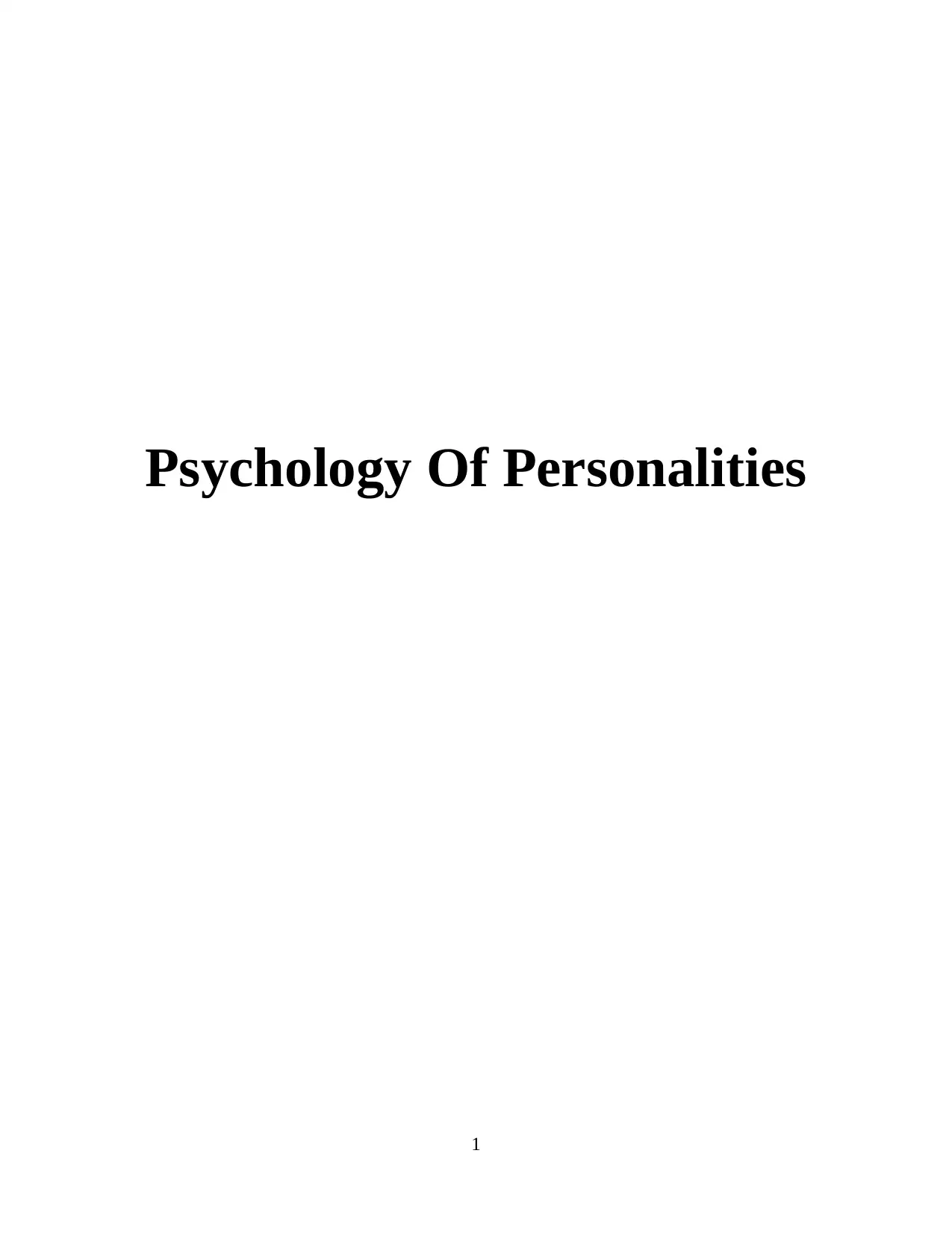
Psychology Of Personalities
1
1
Paraphrase This Document
Need a fresh take? Get an instant paraphrase of this document with our AI Paraphraser

ABSTRACT
The aim of this study is to determine the huge two meta trait of personality and their relation
with creative self-concept and cognitive abilities. Two huge meta traits which were found in this
report is stability and plasticity. Test like Short Scale of Creative Self, Alternate Utility Task
Remote Associates Task are utilised for evaluating creative self concept and different cognitive
abilities. After recording the response of participants mean and standard deviation are calculated.
The standard deviation of age, sex, RAT, AUT, stability, plasticity and SSCS are 6.749, 0.462,
0.08943, 0.35348, 25.927, 18.771, 0.70081 respectively. The mean of age, sex, RAT, AUT,
stability, plasticity and SSCS are 24.35, 1.30, 0.1246, 1.8879, 249.75, 167.61, 3.6332
respectively. Through findings and discussion it can be stated that huge two meta trait of
personality have relation with creative self-concept and cognitive abilities.
2
The aim of this study is to determine the huge two meta trait of personality and their relation
with creative self-concept and cognitive abilities. Two huge meta traits which were found in this
report is stability and plasticity. Test like Short Scale of Creative Self, Alternate Utility Task
Remote Associates Task are utilised for evaluating creative self concept and different cognitive
abilities. After recording the response of participants mean and standard deviation are calculated.
The standard deviation of age, sex, RAT, AUT, stability, plasticity and SSCS are 6.749, 0.462,
0.08943, 0.35348, 25.927, 18.771, 0.70081 respectively. The mean of age, sex, RAT, AUT,
stability, plasticity and SSCS are 24.35, 1.30, 0.1246, 1.8879, 249.75, 167.61, 3.6332
respectively. Through findings and discussion it can be stated that huge two meta trait of
personality have relation with creative self-concept and cognitive abilities.
2

Table of Contents
ABSTRACT.....................................................................................................................................2
INTRODUCTION...........................................................................................................................4
Background.............................................................................................................................4
Rationale ................................................................................................................................5
The basic understanding about psychology of personalities..................................................5
The relationships between the Huge Two meta-traits of personality and creative self-concept.6
METHODOLOGY ........................................................................................................................7
Type of investigation..............................................................................................................7
Data collection method...........................................................................................................7
Participants and demographic variables.................................................................................7
Personality..............................................................................................................................8
Creative self concept .............................................................................................................8
Creativity task ........................................................................................................................8
RESULT..........................................................................................................................................8
DISCUSSION..................................................................................................................................7
REFERENCE.................................................................................................................................10
3
ABSTRACT.....................................................................................................................................2
INTRODUCTION...........................................................................................................................4
Background.............................................................................................................................4
Rationale ................................................................................................................................5
The basic understanding about psychology of personalities..................................................5
The relationships between the Huge Two meta-traits of personality and creative self-concept.6
METHODOLOGY ........................................................................................................................7
Type of investigation..............................................................................................................7
Data collection method...........................................................................................................7
Participants and demographic variables.................................................................................7
Personality..............................................................................................................................8
Creative self concept .............................................................................................................8
Creativity task ........................................................................................................................8
RESULT..........................................................................................................................................8
DISCUSSION..................................................................................................................................7
REFERENCE.................................................................................................................................10
3
⊘ This is a preview!⊘
Do you want full access?
Subscribe today to unlock all pages.

Trusted by 1+ million students worldwide
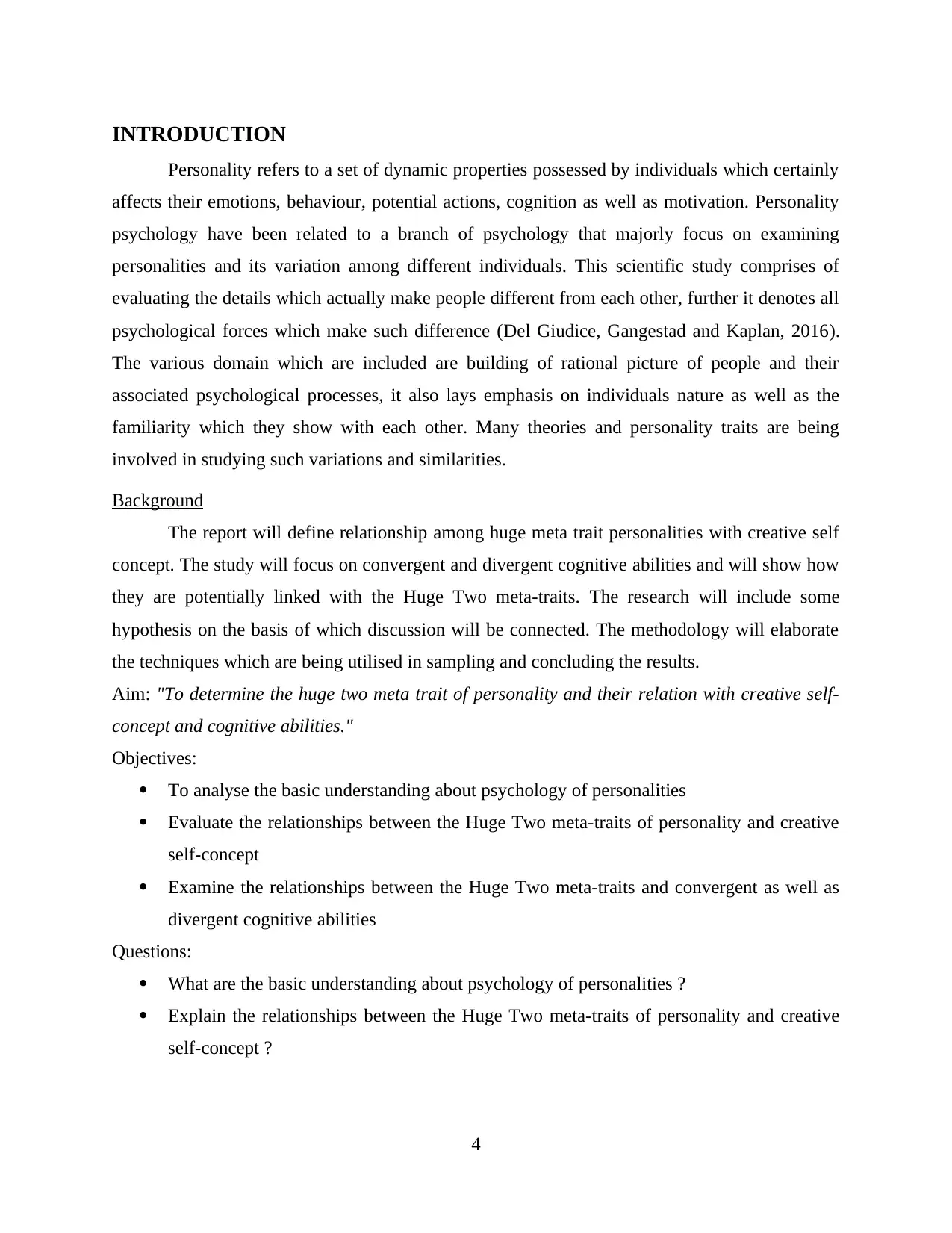
INTRODUCTION
Personality refers to a set of dynamic properties possessed by individuals which certainly
affects their emotions, behaviour, potential actions, cognition as well as motivation. Personality
psychology have been related to a branch of psychology that majorly focus on examining
personalities and its variation among different individuals. This scientific study comprises of
evaluating the details which actually make people different from each other, further it denotes all
psychological forces which make such difference (Del Giudice, Gangestad and Kaplan, 2016).
The various domain which are included are building of rational picture of people and their
associated psychological processes, it also lays emphasis on individuals nature as well as the
familiarity which they show with each other. Many theories and personality traits are being
involved in studying such variations and similarities.
Background
The report will define relationship among huge meta trait personalities with creative self
concept. The study will focus on convergent and divergent cognitive abilities and will show how
they are potentially linked with the Huge Two meta-traits. The research will include some
hypothesis on the basis of which discussion will be connected. The methodology will elaborate
the techniques which are being utilised in sampling and concluding the results.
Aim: "To determine the huge two meta trait of personality and their relation with creative self-
concept and cognitive abilities."
Objectives:
To analyse the basic understanding about psychology of personalities
Evaluate the relationships between the Huge Two meta-traits of personality and creative
self-concept
Examine the relationships between the Huge Two meta-traits and convergent as well as
divergent cognitive abilities
Questions:
What are the basic understanding about psychology of personalities ?
Explain the relationships between the Huge Two meta-traits of personality and creative
self-concept ?
4
Personality refers to a set of dynamic properties possessed by individuals which certainly
affects their emotions, behaviour, potential actions, cognition as well as motivation. Personality
psychology have been related to a branch of psychology that majorly focus on examining
personalities and its variation among different individuals. This scientific study comprises of
evaluating the details which actually make people different from each other, further it denotes all
psychological forces which make such difference (Del Giudice, Gangestad and Kaplan, 2016).
The various domain which are included are building of rational picture of people and their
associated psychological processes, it also lays emphasis on individuals nature as well as the
familiarity which they show with each other. Many theories and personality traits are being
involved in studying such variations and similarities.
Background
The report will define relationship among huge meta trait personalities with creative self
concept. The study will focus on convergent and divergent cognitive abilities and will show how
they are potentially linked with the Huge Two meta-traits. The research will include some
hypothesis on the basis of which discussion will be connected. The methodology will elaborate
the techniques which are being utilised in sampling and concluding the results.
Aim: "To determine the huge two meta trait of personality and their relation with creative self-
concept and cognitive abilities."
Objectives:
To analyse the basic understanding about psychology of personalities
Evaluate the relationships between the Huge Two meta-traits of personality and creative
self-concept
Examine the relationships between the Huge Two meta-traits and convergent as well as
divergent cognitive abilities
Questions:
What are the basic understanding about psychology of personalities ?
Explain the relationships between the Huge Two meta-traits of personality and creative
self-concept ?
4
Paraphrase This Document
Need a fresh take? Get an instant paraphrase of this document with our AI Paraphraser
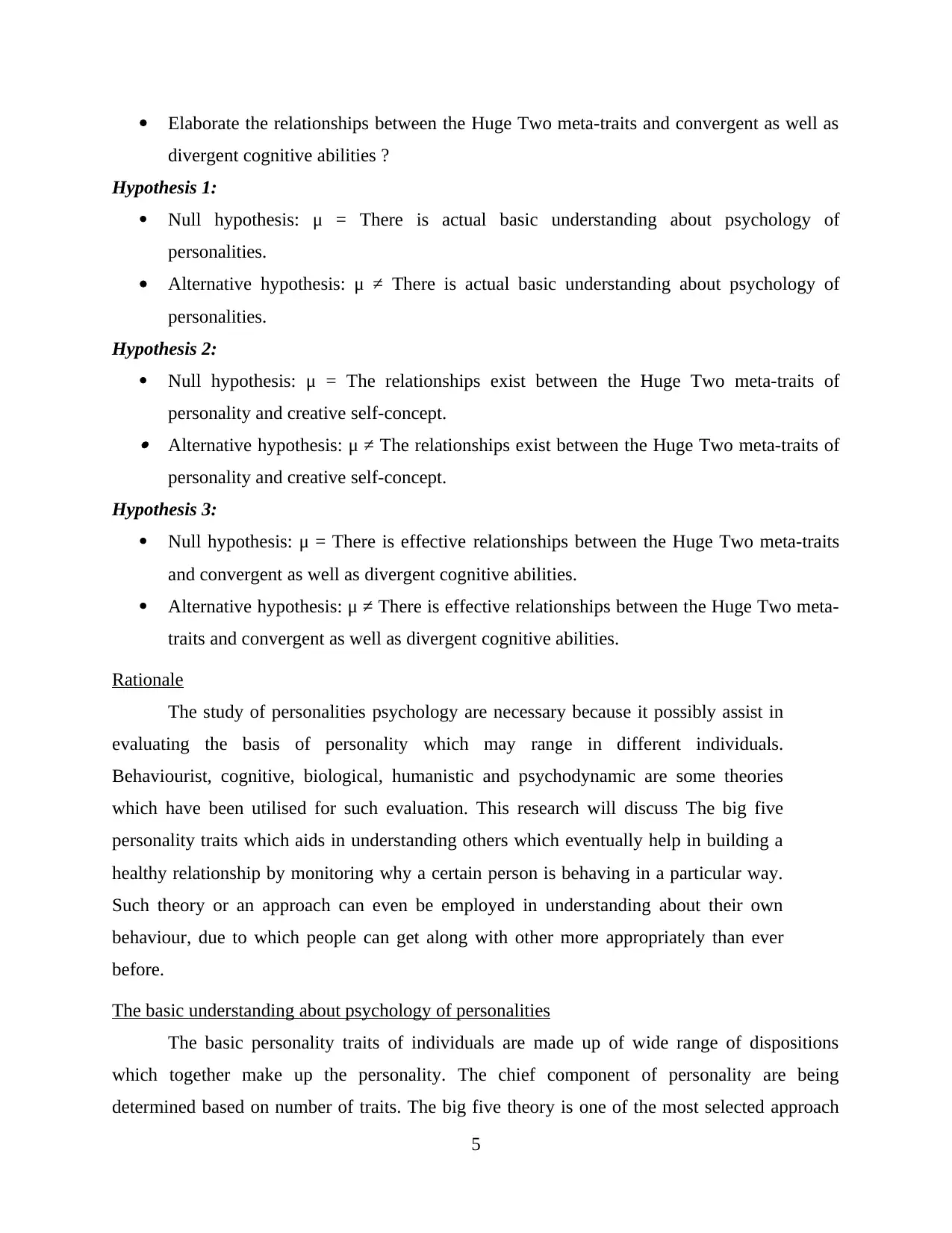
Elaborate the relationships between the Huge Two meta-traits and convergent as well as
divergent cognitive abilities ?
Hypothesis 1:
Null hypothesis: μ = There is actual basic understanding about psychology of
personalities.
Alternative hypothesis: μ ≠ There is actual basic understanding about psychology of
personalities.
Hypothesis 2:
Null hypothesis: μ = The relationships exist between the Huge Two meta-traits of
personality and creative self-concept. Alternative hypothesis: μ ≠ The relationships exist between the Huge Two meta-traits of
personality and creative self-concept.
Hypothesis 3:
Null hypothesis: μ = There is effective relationships between the Huge Two meta-traits
and convergent as well as divergent cognitive abilities.
Alternative hypothesis: μ ≠ There is effective relationships between the Huge Two meta-
traits and convergent as well as divergent cognitive abilities.
Rationale
The study of personalities psychology are necessary because it possibly assist in
evaluating the basis of personality which may range in different individuals.
Behaviourist, cognitive, biological, humanistic and psychodynamic are some theories
which have been utilised for such evaluation. This research will discuss The big five
personality traits which aids in understanding others which eventually help in building a
healthy relationship by monitoring why a certain person is behaving in a particular way.
Such theory or an approach can even be employed in understanding about their own
behaviour, due to which people can get along with other more appropriately than ever
before.
The basic understanding about psychology of personalities
The basic personality traits of individuals are made up of wide range of dispositions
which together make up the personality. The chief component of personality are being
determined based on number of traits. The big five theory is one of the most selected approach
5
divergent cognitive abilities ?
Hypothesis 1:
Null hypothesis: μ = There is actual basic understanding about psychology of
personalities.
Alternative hypothesis: μ ≠ There is actual basic understanding about psychology of
personalities.
Hypothesis 2:
Null hypothesis: μ = The relationships exist between the Huge Two meta-traits of
personality and creative self-concept. Alternative hypothesis: μ ≠ The relationships exist between the Huge Two meta-traits of
personality and creative self-concept.
Hypothesis 3:
Null hypothesis: μ = There is effective relationships between the Huge Two meta-traits
and convergent as well as divergent cognitive abilities.
Alternative hypothesis: μ ≠ There is effective relationships between the Huge Two meta-
traits and convergent as well as divergent cognitive abilities.
Rationale
The study of personalities psychology are necessary because it possibly assist in
evaluating the basis of personality which may range in different individuals.
Behaviourist, cognitive, biological, humanistic and psychodynamic are some theories
which have been utilised for such evaluation. This research will discuss The big five
personality traits which aids in understanding others which eventually help in building a
healthy relationship by monitoring why a certain person is behaving in a particular way.
Such theory or an approach can even be employed in understanding about their own
behaviour, due to which people can get along with other more appropriately than ever
before.
The basic understanding about psychology of personalities
The basic personality traits of individuals are made up of wide range of dispositions
which together make up the personality. The chief component of personality are being
determined based on number of traits. The big five theory is one of the most selected approach
5
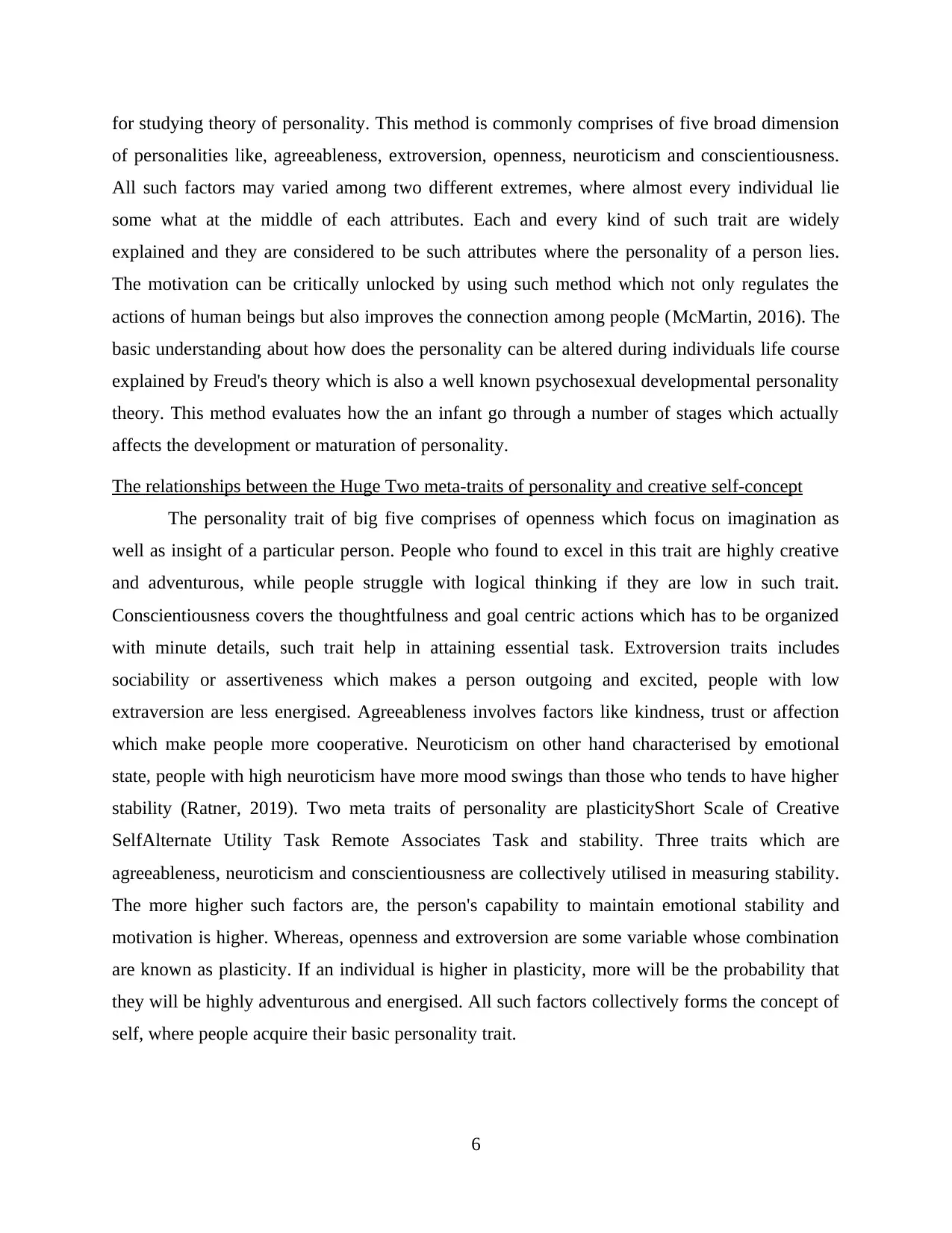
for studying theory of personality. This method is commonly comprises of five broad dimension
of personalities like, agreeableness, extroversion, openness, neuroticism and conscientiousness.
All such factors may varied among two different extremes, where almost every individual lie
some what at the middle of each attributes. Each and every kind of such trait are widely
explained and they are considered to be such attributes where the personality of a person lies.
The motivation can be critically unlocked by using such method which not only regulates the
actions of human beings but also improves the connection among people (McMartin, 2016). The
basic understanding about how does the personality can be altered during individuals life course
explained by Freud's theory which is also a well known psychosexual developmental personality
theory. This method evaluates how the an infant go through a number of stages which actually
affects the development or maturation of personality.
The relationships between the Huge Two meta-traits of personality and creative self-concept
The personality trait of big five comprises of openness which focus on imagination as
well as insight of a particular person. People who found to excel in this trait are highly creative
and adventurous, while people struggle with logical thinking if they are low in such trait.
Conscientiousness covers the thoughtfulness and goal centric actions which has to be organized
with minute details, such trait help in attaining essential task. Extroversion traits includes
sociability or assertiveness which makes a person outgoing and excited, people with low
extraversion are less energised. Agreeableness involves factors like kindness, trust or affection
which make people more cooperative. Neuroticism on other hand characterised by emotional
state, people with high neuroticism have more mood swings than those who tends to have higher
stability (Ratner, 2019). Two meta traits of personality are plasticityShort Scale of Creative
SelfAlternate Utility Task Remote Associates Task and stability. Three traits which are
agreeableness, neuroticism and conscientiousness are collectively utilised in measuring stability.
The more higher such factors are, the person's capability to maintain emotional stability and
motivation is higher. Whereas, openness and extroversion are some variable whose combination
are known as plasticity. If an individual is higher in plasticity, more will be the probability that
they will be highly adventurous and energised. All such factors collectively forms the concept of
self, where people acquire their basic personality trait.
6
of personalities like, agreeableness, extroversion, openness, neuroticism and conscientiousness.
All such factors may varied among two different extremes, where almost every individual lie
some what at the middle of each attributes. Each and every kind of such trait are widely
explained and they are considered to be such attributes where the personality of a person lies.
The motivation can be critically unlocked by using such method which not only regulates the
actions of human beings but also improves the connection among people (McMartin, 2016). The
basic understanding about how does the personality can be altered during individuals life course
explained by Freud's theory which is also a well known psychosexual developmental personality
theory. This method evaluates how the an infant go through a number of stages which actually
affects the development or maturation of personality.
The relationships between the Huge Two meta-traits of personality and creative self-concept
The personality trait of big five comprises of openness which focus on imagination as
well as insight of a particular person. People who found to excel in this trait are highly creative
and adventurous, while people struggle with logical thinking if they are low in such trait.
Conscientiousness covers the thoughtfulness and goal centric actions which has to be organized
with minute details, such trait help in attaining essential task. Extroversion traits includes
sociability or assertiveness which makes a person outgoing and excited, people with low
extraversion are less energised. Agreeableness involves factors like kindness, trust or affection
which make people more cooperative. Neuroticism on other hand characterised by emotional
state, people with high neuroticism have more mood swings than those who tends to have higher
stability (Ratner, 2019). Two meta traits of personality are plasticityShort Scale of Creative
SelfAlternate Utility Task Remote Associates Task and stability. Three traits which are
agreeableness, neuroticism and conscientiousness are collectively utilised in measuring stability.
The more higher such factors are, the person's capability to maintain emotional stability and
motivation is higher. Whereas, openness and extroversion are some variable whose combination
are known as plasticity. If an individual is higher in plasticity, more will be the probability that
they will be highly adventurous and energised. All such factors collectively forms the concept of
self, where people acquire their basic personality trait.
6
⊘ This is a preview!⊘
Do you want full access?
Subscribe today to unlock all pages.

Trusted by 1+ million students worldwide
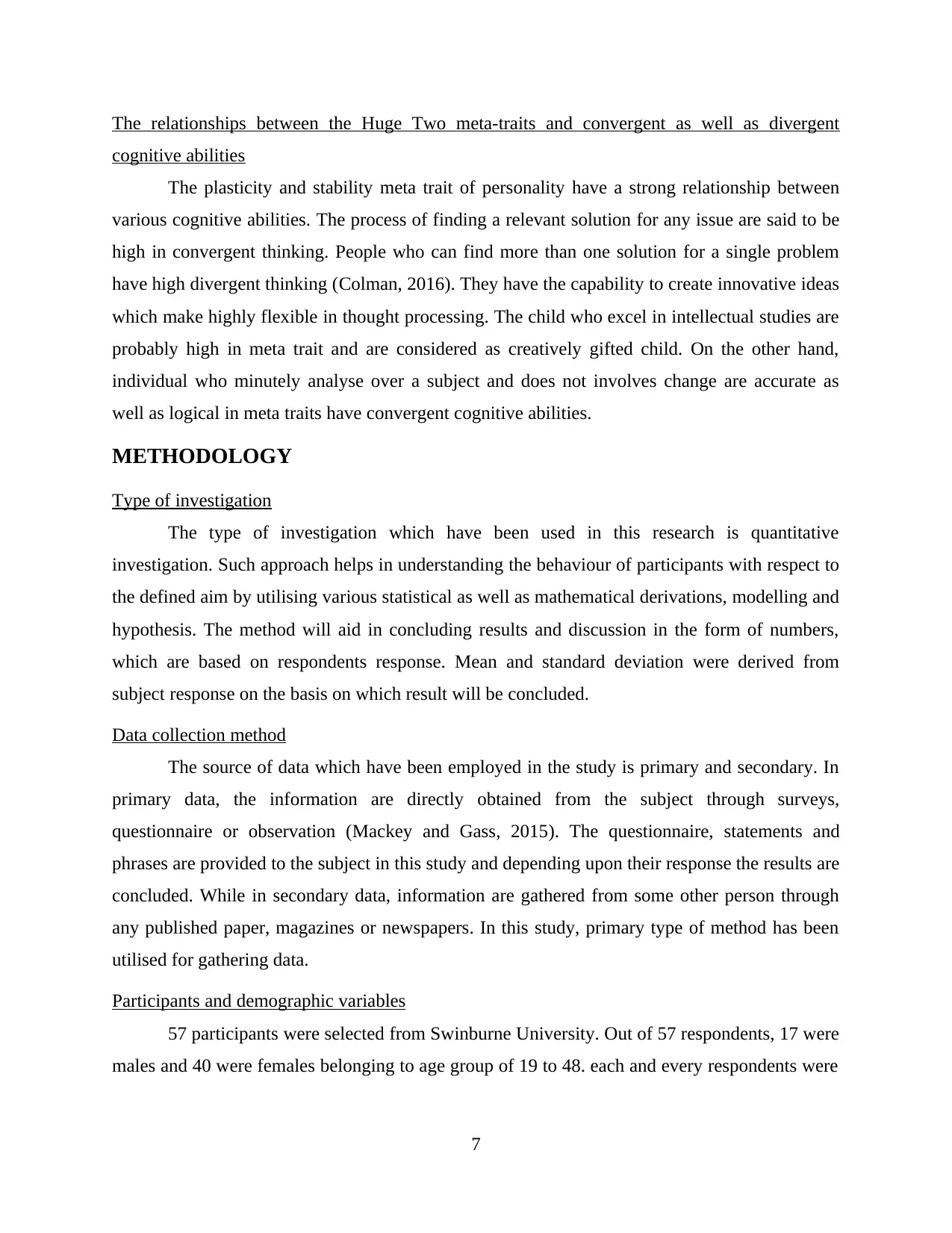
The relationships between the Huge Two meta-traits and convergent as well as divergent
cognitive abilities
The plasticity and stability meta trait of personality have a strong relationship between
various cognitive abilities. The process of finding a relevant solution for any issue are said to be
high in convergent thinking. People who can find more than one solution for a single problem
have high divergent thinking (Colman, 2016). They have the capability to create innovative ideas
which make highly flexible in thought processing. The child who excel in intellectual studies are
probably high in meta trait and are considered as creatively gifted child. On the other hand,
individual who minutely analyse over a subject and does not involves change are accurate as
well as logical in meta traits have convergent cognitive abilities.
METHODOLOGY
Type of investigation
The type of investigation which have been used in this research is quantitative
investigation. Such approach helps in understanding the behaviour of participants with respect to
the defined aim by utilising various statistical as well as mathematical derivations, modelling and
hypothesis. The method will aid in concluding results and discussion in the form of numbers,
which are based on respondents response. Mean and standard deviation were derived from
subject response on the basis on which result will be concluded.
Data collection method
The source of data which have been employed in the study is primary and secondary. In
primary data, the information are directly obtained from the subject through surveys,
questionnaire or observation (Mackey and Gass, 2015). The questionnaire, statements and
phrases are provided to the subject in this study and depending upon their response the results are
concluded. While in secondary data, information are gathered from some other person through
any published paper, magazines or newspapers. In this study, primary type of method has been
utilised for gathering data.
Participants and demographic variables
57 participants were selected from Swinburne University. Out of 57 respondents, 17 were
males and 40 were females belonging to age group of 19 to 48. each and every respondents were
7
cognitive abilities
The plasticity and stability meta trait of personality have a strong relationship between
various cognitive abilities. The process of finding a relevant solution for any issue are said to be
high in convergent thinking. People who can find more than one solution for a single problem
have high divergent thinking (Colman, 2016). They have the capability to create innovative ideas
which make highly flexible in thought processing. The child who excel in intellectual studies are
probably high in meta trait and are considered as creatively gifted child. On the other hand,
individual who minutely analyse over a subject and does not involves change are accurate as
well as logical in meta traits have convergent cognitive abilities.
METHODOLOGY
Type of investigation
The type of investigation which have been used in this research is quantitative
investigation. Such approach helps in understanding the behaviour of participants with respect to
the defined aim by utilising various statistical as well as mathematical derivations, modelling and
hypothesis. The method will aid in concluding results and discussion in the form of numbers,
which are based on respondents response. Mean and standard deviation were derived from
subject response on the basis on which result will be concluded.
Data collection method
The source of data which have been employed in the study is primary and secondary. In
primary data, the information are directly obtained from the subject through surveys,
questionnaire or observation (Mackey and Gass, 2015). The questionnaire, statements and
phrases are provided to the subject in this study and depending upon their response the results are
concluded. While in secondary data, information are gathered from some other person through
any published paper, magazines or newspapers. In this study, primary type of method has been
utilised for gathering data.
Participants and demographic variables
57 participants were selected from Swinburne University. Out of 57 respondents, 17 were
males and 40 were females belonging to age group of 19 to 48. each and every respondents were
7
Paraphrase This Document
Need a fresh take? Get an instant paraphrase of this document with our AI Paraphraser

priorly informed about the study. After there proper consent the research were conducted and
people were rated purely basis on their response.
Personality
The respondents were selected to assess stability as well as plasticity personality trait. It
actually focuses on big five personality trait (McDougall, 2015). Some phrases have been
presented to such subjects on the basis of which they are examined and rated from 1 to 5.
Plasticity scores were summoned by the help of openness, extroversion factors while stability
score was calculated with respect to neuroticism, agreeableness and conscientiousness.
Creative self concept
The Short Scale of Creative Self (SSCS) was utilised in measuring creative self concept.
Participants were judged on basis of some statements. The way they reflected their self concept
were recorded and score were provided ranging from 1 to 5.
Creativity task
For divergent cognitive abilities, respondents were asked to think as many uses of certain
items based on Alternate Utility Task (AUT) as possible within 3 minutes. Each and every
response were rated from 1 to 5. For convergent thinking abilities, subject were asked to write
similar words based on Remote Associates Task (RAT) which were represented in front of them
within 3 minutes. The scores were again rated on basis of their promptShort Scale of Creative
SelfAlternate Utility Task Remote Associates Taskness.
RESULT
From 57 participants, response were generated on basis of various test and then the
records were set up to further investigate the study's aim. The table of responses have been
generated on the basis of which further conclusion and discussion will be dependent upon. On
the basis of mean and standard deviation the results are calculated and graphs are made to
authenticate the study. The standard deviation has a relationship with variance. More the
standard deviation will be less will be the variance. Less the standard deviation will be more will
b the variance On such basis the results are concluded and it suggest that personality trait like
plasticity, stability, creative self concept and creativity task will be evaluated.
8
people were rated purely basis on their response.
Personality
The respondents were selected to assess stability as well as plasticity personality trait. It
actually focuses on big five personality trait (McDougall, 2015). Some phrases have been
presented to such subjects on the basis of which they are examined and rated from 1 to 5.
Plasticity scores were summoned by the help of openness, extroversion factors while stability
score was calculated with respect to neuroticism, agreeableness and conscientiousness.
Creative self concept
The Short Scale of Creative Self (SSCS) was utilised in measuring creative self concept.
Participants were judged on basis of some statements. The way they reflected their self concept
were recorded and score were provided ranging from 1 to 5.
Creativity task
For divergent cognitive abilities, respondents were asked to think as many uses of certain
items based on Alternate Utility Task (AUT) as possible within 3 minutes. Each and every
response were rated from 1 to 5. For convergent thinking abilities, subject were asked to write
similar words based on Remote Associates Task (RAT) which were represented in front of them
within 3 minutes. The scores were again rated on basis of their promptShort Scale of Creative
SelfAlternate Utility Task Remote Associates Taskness.
RESULT
From 57 participants, response were generated on basis of various test and then the
records were set up to further investigate the study's aim. The table of responses have been
generated on the basis of which further conclusion and discussion will be dependent upon. On
the basis of mean and standard deviation the results are calculated and graphs are made to
authenticate the study. The standard deviation has a relationship with variance. More the
standard deviation will be less will be the variance. Less the standard deviation will be more will
b the variance On such basis the results are concluded and it suggest that personality trait like
plasticity, stability, creative self concept and creativity task will be evaluated.
8
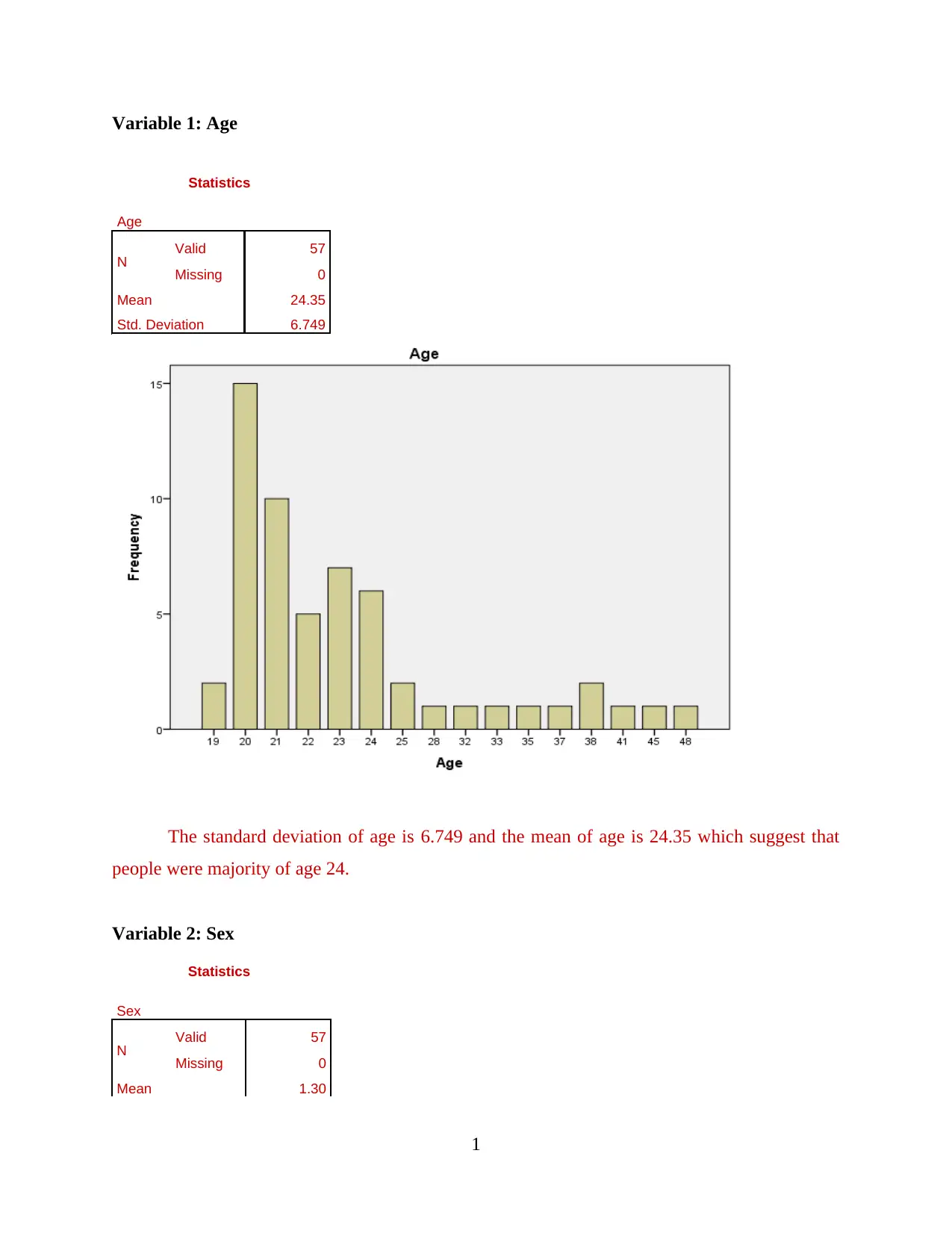
Variable 1: Age
Statistics
Age
N Valid 57
Missing 0
Mean 24.35
Std. Deviation 6.749
The standard deviation of age is 6.749 and the mean of age is 24.35 which suggest that
people were majority of age 24.
Variable 2: Sex
Statistics
Sex
N Valid 57
Missing 0
Mean 1.30
1
Statistics
Age
N Valid 57
Missing 0
Mean 24.35
Std. Deviation 6.749
The standard deviation of age is 6.749 and the mean of age is 24.35 which suggest that
people were majority of age 24.
Variable 2: Sex
Statistics
Sex
N Valid 57
Missing 0
Mean 1.30
1
⊘ This is a preview!⊘
Do you want full access?
Subscribe today to unlock all pages.

Trusted by 1+ million students worldwide
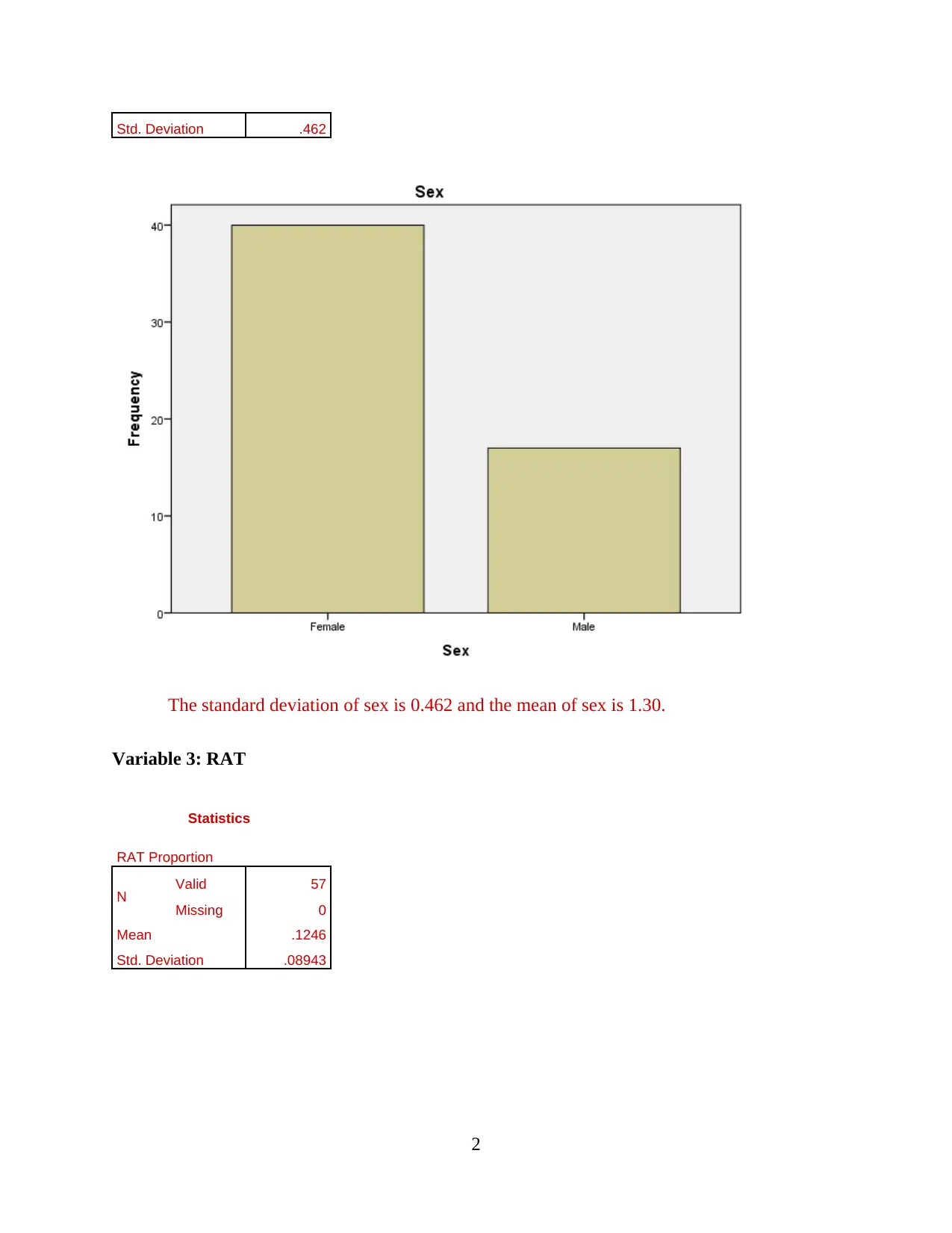
Std. Deviation .462
The standard deviation of sex is 0.462 and the mean of sex is 1.30.
Variable 3: RAT
Statistics
RAT Proportion
N Valid 57
Missing 0
Mean .1246
Std. Deviation .08943
2
The standard deviation of sex is 0.462 and the mean of sex is 1.30.
Variable 3: RAT
Statistics
RAT Proportion
N Valid 57
Missing 0
Mean .1246
Std. Deviation .08943
2
Paraphrase This Document
Need a fresh take? Get an instant paraphrase of this document with our AI Paraphraser
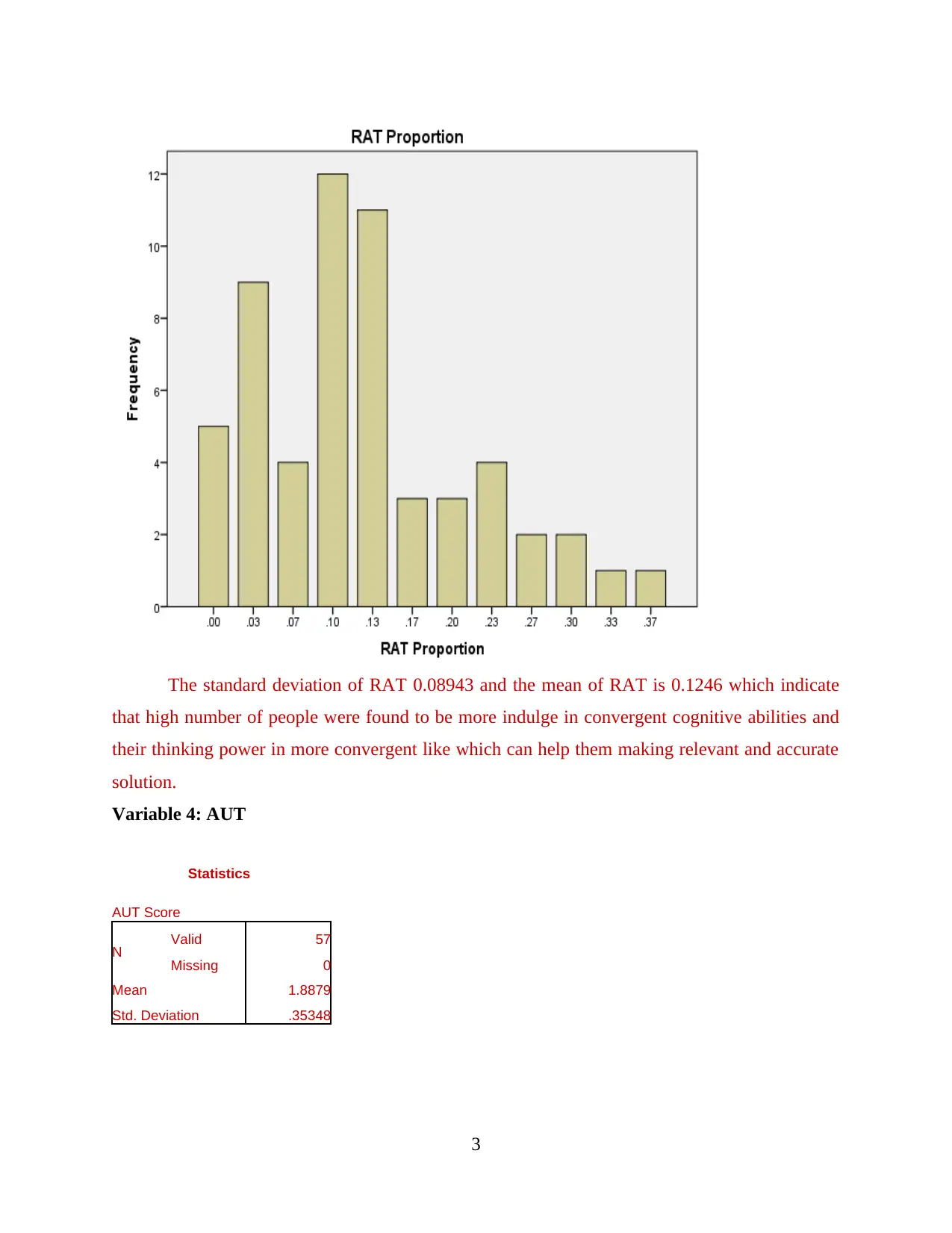
The standard deviation of RAT 0.08943 and the mean of RAT is 0.1246 which indicate
that high number of people were found to be more indulge in convergent cognitive abilities and
their thinking power in more convergent like which can help them making relevant and accurate
solution.
Variable 4: AUT
Statistics
AUT Score
N Valid 57
Missing 0
Mean 1.8879
Std. Deviation .35348
3
that high number of people were found to be more indulge in convergent cognitive abilities and
their thinking power in more convergent like which can help them making relevant and accurate
solution.
Variable 4: AUT
Statistics
AUT Score
N Valid 57
Missing 0
Mean 1.8879
Std. Deviation .35348
3
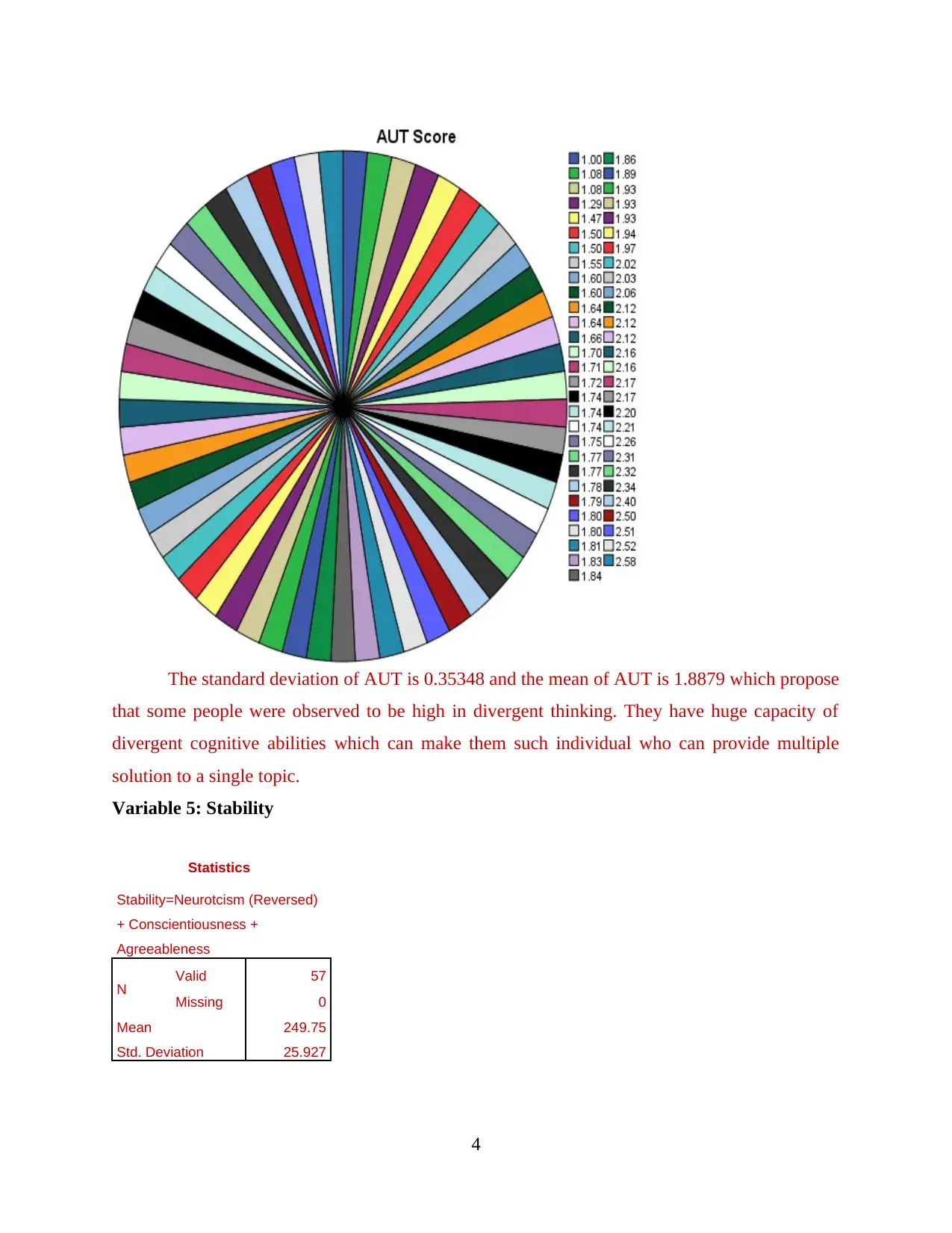
The standard deviation of AUT is 0.35348 and the mean of AUT is 1.8879 which propose
that some people were observed to be high in divergent thinking. They have huge capacity of
divergent cognitive abilities which can make them such individual who can provide multiple
solution to a single topic.
Variable 5: Stability
Statistics
Stability=Neurotcism (Reversed)
+ Conscientiousness +
Agreeableness
N Valid 57
Missing 0
Mean 249.75
Std. Deviation 25.927
4
that some people were observed to be high in divergent thinking. They have huge capacity of
divergent cognitive abilities which can make them such individual who can provide multiple
solution to a single topic.
Variable 5: Stability
Statistics
Stability=Neurotcism (Reversed)
+ Conscientiousness +
Agreeableness
N Valid 57
Missing 0
Mean 249.75
Std. Deviation 25.927
4
⊘ This is a preview!⊘
Do you want full access?
Subscribe today to unlock all pages.

Trusted by 1+ million students worldwide
1 out of 18
Related Documents
Your All-in-One AI-Powered Toolkit for Academic Success.
+13062052269
info@desklib.com
Available 24*7 on WhatsApp / Email
![[object Object]](/_next/static/media/star-bottom.7253800d.svg)
Unlock your academic potential
Copyright © 2020–2026 A2Z Services. All Rights Reserved. Developed and managed by ZUCOL.




